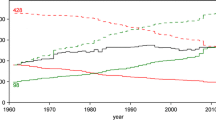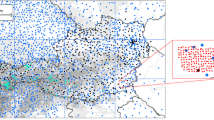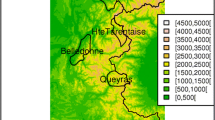Abstract
The spatial auto-correlation of minimum temperature was analyzed for a topoclimatological station network in the Huleh Valley of Israel on radiation cooling nights, using the method of optimum interpolation. Only a few stations all of which are situated in a flat area along the longitudinal central axis, exhibited a distinct dependence of the auto-correlation with distance. These stations were less representative of the entire valley compared with sites close to the slopes.
The more varied topography near the edges of the valley leaves its stamp on the auto-correlation field in two specific ways:
-
(a)
Due to the more sloping surface, the increased randomness on the microscale diminishes and more generally obscures the dependence of the auto-correlation with distance from a given reference station.
-
(b)
The increased mixing associated with the slope-induced airflow increases the areal auto-correlation surrounding a given station.
Since the representativeness is to a great extent determined by the magnitude of the auto-correlation, the boundary stations are found to be more representative compared with stations in the central part of the valley. The pattern of representativeness changes significantly when the auto-correlation is averaged over a distance approximately equal to that of the east-west dimension, and half that of the north-south dimension. A localization effect is observed, in which two sub-areas are delineated, one in the north and the other in the south, and each is best represented by a relatively flat site in the north and central sectors of the valley.
Similar content being viewed by others
References
Gat, Z., Lomas, J., Borsok, Z., and Barak, U.: 1972, Climatological and Topoclimatological Analysis of The Huleh Valley, Israel Meteorol. Serv., Report (in Hebrew).
Kruger, H. B.: 1968, General And Special Approaches to The Problem of Objective Analysis Of Meteorological Variables, Tellus 15, 127–149.
Lomas, J. and Gat, Z.: 1971, Methods of Agrotopoclimatological Surveys - Minimum Temperatures, Israel Meteorol. Serv. Report 1–71. (in Hebrew).
McCracken, D. D. and Dorn, W. S.: 1964, Numerical Methods and Fortran Programming, John Wiley and Sons Inc., New York.
MacHattie, L. B. and Schnelle, F.: 1974, An Introduction to Agrotopoclimatology, WMO Technica Note No. 133. WMO-No. 378.
Munn, R. E.: 1975, Suspended Particulate Concentrations: Spatial Correlations in The Detroit-Windsor Area, Tellus 27, 397–405.
Okamoto, M. and Webb, F. K.: 1970, The Temperature Fluctuations in Stable Stratification, Quart. J. Royal Meteorol. Soc. 96, 591–600.
Wiener N.: 1949, Extrapolation, Interpolation and Smoothing of Stationary Time Series, Technology Press of M.I.T., Cambridge, Mass., U.S.A.
Author information
Authors and Affiliations
Rights and permissions
About this article
Cite this article
Zemel, Z., Lomas, J. An objective method for assessing representativeness of a station network measuring minimum temperature near the ground. Boundary-Layer Meteorol 10, 3–14 (1976). https://doi.org/10.1007/BF00218721
Revised:
Issue Date:
DOI: https://doi.org/10.1007/BF00218721




